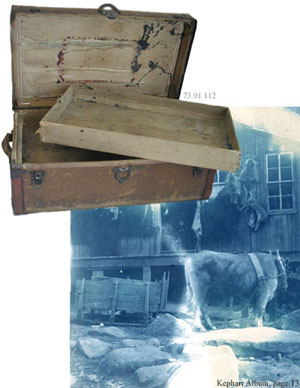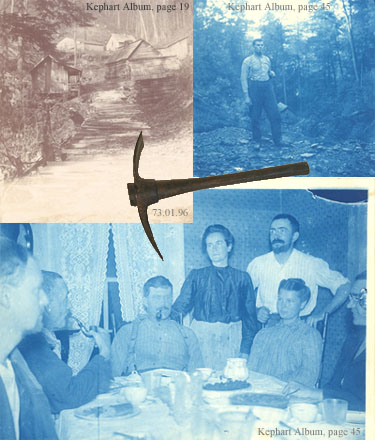|
Horace Kephart arrived at Medlin on Hazel Creek, Swain County, in early
November 1904. Here he obtained permission to live in an abandoned cabin
at the nearby Everett Copper Mine where mining operations had stalled
under litigation. He lived here, with some absences such as summers at
Hall Cabin, for three years. As with his few months of living near Dillsboro,
North Carolina, he immediately began to write down his observations about
the natural environment, his activities, and his new neighbors.
Kephart also developed an interest in the local mining industry, later
adding notes and clippings on the topic to his journals. Industrial mining
operations such as that at the copper mines were later contrasted with
the individual search for hidden minerals in his novel Smoky Mountain
Magic that incorporated many of his western North Carolina experiences.
Far more of a nonfiction writer, Kephart's novel remains unpublished.
|
|
 Kephart
traveled to both the cities of Europe
and the cabins of Appalachia during
his lifetime. In any case where some
form of transportation was available,
he packed his belongings in steamer
trunks. When he arrived at Medlin,
North Carolina, an ox drawn summer
sled carried his trunk from Granville
Calhoun's store. Kephart
traveled to both the cities of Europe
and the cabins of Appalachia during
his lifetime. In any case where some
form of transportation was available,
he packed his belongings in steamer
trunks. When he arrived at Medlin,
North Carolina, an ox drawn summer
sled carried his trunk from Granville
Calhoun's store.
From the 1921 edition of Our Southern Highlanders, pages 29-31:
When I went south into the mountains I was seeking a Back of Beyond.
This for more reasons than one. With an inborn taste for the wild and
romantic, I yearned for a strange land and a people that had the charm
of originality. Again, I had a passion for early American history; and,
in Far Appalachia, it seemed that I might realize the past in the present,
seeing with my own eyes what life must have been to my pioneer ancestors
of a century or two ago. Besides, I wanted to enjoy a free life in the
open air, the thrill of exploring new ground, the joys of the chase, and
the man's game of matching my woodcraft against the force of nature, with
no help from servants or hired guides.
So, casting about for a biding place that would fill such needs, I
picked out the upper settlement of Hazel Creek, far up under the lee of
those Smoky Mountains that I had learned so little about. On the edge
of this settlement, scant two miles from the post office of Medlin, there
was a copper mine, long disused on account of litigation, and I got permission
to occupy one of its abandoned cabins.
A mountain settlement consists of all who get their mail at the same
place. Ours was made up of forty-two households (about two hundred souls)
scattered over an area eight miles long by two miles wide. These are air-line
measurements. All roads and trails "wiggled and wingled around"
so that some families were several miles from a neighbor. Fifteen homes
had no wagon road, and could be reached by no vehicle other than a narrow
sled. Quill Rose had not even a sledpath, but journeyed full five miles
by trail to the nearest wagon road.
Medlin itself comprised two little stores built of rough planks and
bearing no signs, a corn mill, and four dwellings. A mile and a half away
was the log schoolhouse, which, once or twice a month, served also as
a church. Scattered about the settlement were seven tiny tub-mills for
grinding corn, some of them mere open sheds with a capacity of about a
bushel a day. Most of the dwellings were built of logs. Two or three,
only, were weatherboarded frame houses and attained the dignity of about
a story and a half.
All about us was the forest primeval, where roamed some sparse herds
of cattle, razorback hogs, and the wild beasts. Speckled trout were in
all the streams. Bears sometimes raided the fields, and wildcats were
a common nuisance. Our settlement was a mere slash in the vast woodland
that encompassed it.
|

Soon after arriving in Medlin,
Kephart developed a friendship
with Bob Barnett who stayed
in the foreman's house of the
mine. Throughout his writings,
Kephart mentioned Bob Barnett,
usually referred to as simply
"Bob", and his family
and the influence that they
had on his life in North Carolina.
Mrs. Barnett was credited for
her culinary skills in Kephart's
book Camp Cookery. Bob
was described as a source of
"wisdom" and outdoor
experiences upon which he was
able to draw and learn from,
and which helped him hone his
own advice.
Kephart mentioned his friend in the July 1921 All Outdoors
"Roving with Kephart": "One day last fall I had
a visit from my old partner, Bob Barnett, and his wife. He is the
big, fat Bob who figures in the books 'Camping and Woodcraft' and
'Our Southern Highlanders.' He came, years ago, to the old mine
site where I'd been living alone with the bobcats and hoot-owls,
and became caretaker for the company that had possession. It was
an abandoned place -- that is, no one else lived near there -- and
I welcomed a neighbor. Soon I shifted quarters to his house. We
lived together, in various necks of the woods, for several years.
Bob now is at Aquone, N.C., on the upper Nantahala, where he keeps
open house for all comers."
Likewise, Kephart also moved from Medlin, eventually settling in
the Swain county seat of Bryson City, North Carolina. But the people
and experiences of Medlin, North Carolina, remained an influential
part of his writing career for the remainder of his life.
|